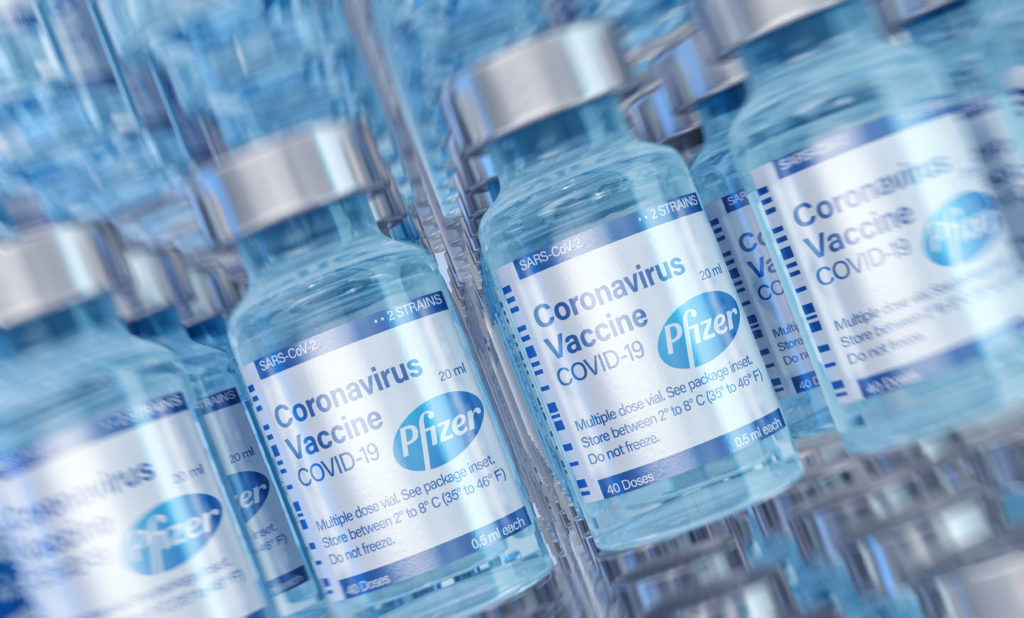When COVID-19 vaccines were in development in late 2020, Johnson & Johnson had the biggest advantage with U.S. consumers. After decades of successful branding of its baby products, the company had established a halo of trust with people across the country.
Since the vaccines became available, J&J has also outspent its rivals, Pfizer and Moderna, on digital advertising.
Yet Pfizer has been, far and away, the big winner in vaccine brand popularity. In an M Booth Health survey of 1,000 demographically diverse adults—conducted online by independent market research and advisory firm Savanta in April 2021—three-quarters of American consumers said they prefer one vaccine over the others. The top three cited preferences were Pfizer (36 percent), Moderna (19 percent) and J&J (17 percent).
Doctors and public health officials have advised people to get any of the vaccines and that none is inferior. But Pfizer won with the help of marketing communications savvy, offering crucial lessons for healthcare marketers and communicators and, frankly, marketers from any industry.
Don’t Rest on First-mover Advantage
Pfizer was the first vaccine to be approved for use in the United States for people aged 16 and older. But Moderna came along just a week later. And both approvals were in December, long before most Americans could access either of them, since limited supplies went to people in certain categories. The J&J vaccine received approval in February, just as vaccines were becoming more widely available.
So, while Pfizer may have impressed some consumers by being first, by the time most people were getting vaccines, all three were available. And the first-mover advantage doesn’t automatically breed lasting success. Just look at Uber, which was not the first ride-hailing app. Pfizer strategically built on its early momentum, and was careful never to cede ground.
Be Visible, Transparent and Human
Our survey shows that Americans have heightened awareness of pharmaceutical brands. With so much attention focused on drug makers, people have come to think of them in more familiar terms, akin to consumer lifestyle brands such as Nike and Amazon. And while this newfound interest has its most immediate impact on the vaccine makers, we found it extends to other pharma brands as well. Bayer, AstraZeneca, Merck, BMS, Lilly, GSK and Novartis have all seen increases in unaided brand recall. We call this shift the Pharma Brandemic, a veritable epidemic of Pharma brand familiarity. COVID-19 vaccines have changed healthcare marketing forever. These brands’ achievements and upheaval of the pandemic have fundamentally altered consumer understanding of pharmaceutical brands in ways that are enduring.
Consumers absolutely want to feel a connection to a brand and the people behind it. Nearly half of respondents said they want to hear more from leaders of pharmaceutical companies. Nearly a third of Latinos, and slightly smaller numbers of Blacks and Asians, said they want more videos from CEOs on social media channels to help them understand medicines and vaccines and how they work. And one-third said that when pharma companies talk openly about challenges they’re facing, it makes them more likeable. This helps explain Pfizer’s success. From CEO Albert Bourla on down, company officials posted open letters, took part in interviews and wrote columns. They were open about setbacks and triumphs. Pfizer showcased its people at work in a documentary with National Geographic.
Bring Consumers Inside Your Product
Consumers today want to know and understand what’s in the products they use. They’re increasingly Googling skincare ingredients and identifying as clean eaters. So, it’s no surprise that they want to understand what’s in vaccines. In our survey, more than half (57 percent) of respondents said they’re now more likely to explore the science behind any medication they take in the future. Of interest, more than six-in-10 (61 percent) Black respondents polled said they’re more likely to ask or learn about the science behind a medicine before they request or accept it, several points higher than other demographic groups. Pfizer succeeded by explaining its vaccine in digestible, human terms.
Align Your Messaging
Pfizer also benefited from a rebrand that was already underway before the pandemic. It stepped up the launch, with the new “Science Will Win” slogan, along with a new logo designed to, as the Wall Street Journal put it, “demonstrate the company’s elevated scientific mission.” This was exactly the message consumers wanted to hear.
Deploy the Right Influencers
Black respondents self-identified as being among the most informed about the vaccines. More than half (52 percent) described themselves as “active” or “super active” in their approach to staying informed. Only Asians reported a higher figure, at 56 percent. Among Latinos, 46 percent said they are “active” or “super active” in staying informed, just edging out white respondents at 45 percent. For minority audiences, online influencers played an especially important role. More than three-in-10 Latino and Black people polled and 19 percent of Whites polled, said they’re most interested in hearing from the health and wellness influencers they follow on social media. In fact, minority audiences are twice as likely as white audiences to turn to Instagram and YouTube to learn about vaccines. Pfizer deployed influencers effectively.
Win the Hashtag War
Pfizer also benefited from something that’s a sign of the times. While the J&J ampersand can’t be used in a hashtag (and #TeamJohnsonAndJohnson is long), #TeamPfizer and #PfizerGang caught on across social platforms.
Our estimates in May showed that Pfizer had about 8.6 million engagements related to the vaccine on Twitter, TikTok and Instagram, while Moderna had 1.7 million and J&J had fewer than 100,000. Through all these steps, Pfizer also successfully rode a wave of earned media, including, effectively, endorsements from celebrities who shared their experiences getting shots. It became the so-called “status vax,” without ever claiming to be superior, which would’ve been a turnoff.
Of course, anything can still happen. There’s no guarantee that Pfizer will maintain its dominance as COVID-19 variants and booster shots spark a new wave of debate and personal decision making. And all the vaccine makers have powerful marketing communications campaigns underway. But Pfizer remains in the lead, and we should all take note.
This story was first reported in O’Dwyer’s: PR News & PR Firm Rankings | O’Dwyer’s PR News (odwyerpr.com)

Karen Strauss is Chief Strategy and Innovation Officer at M Booth Health and is an industry contributor, speaker, panelist and writer. Thanks to O’Dwyer’s: The inside News of PR & Marketing Communications for sharing Karen’s thoughts with us.

